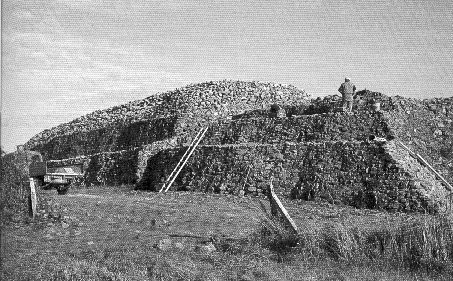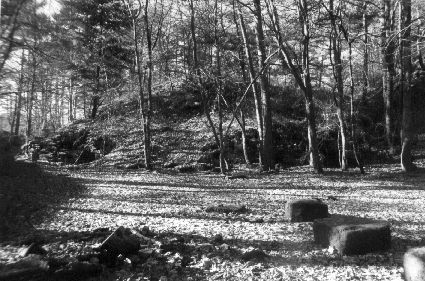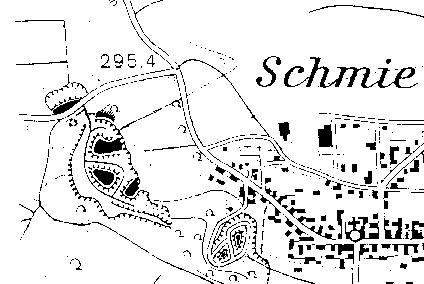Links to other Web-Sites
Web-Site about the Barnenez-Cairn
Web-Site with scotch Cairns
Site about Carnac
Inside view of Cerveteri
The less informed layman and even the expert may be surprised by this fact, but there are good reasons to believe in german pyramids. The archeological outcome offers only one conclusion.
They are the biggest monuments of the Megalith-culture on the continent. Their size even exceeds on all the stony step-pyramids of brittany. There they are called "cairns" - prehistoric grave-houses and step-pyramids built in stone without mortar including one or several burial-chambers like dolmens or vaults of corbel-stone. The most famous example is the "Cairn of Barnenez" (picture 1).

picture 1: Barnenez
The Cairn of Barnenez during its reconstruction at the beginning of the 60s. The steps are planar. Before the disclosure of the burial-chambers, the monument looked like a scree or rubble heap, covered by rubble and debris.Cairns in Europe:
Cairns even are common in Great Britain with the same designation. Generally the spreading of this megalthic tombs (mega = big, lith = stone) reaches from northern Africa, the Balear-islands, over Spain, France, Great Britain, Scandinavia, northern Germany and the northern Switzerland to Poland. Only here in southern Germany there is a blank in the map of dissemination.
It is sayed that in Carnac is the biggest megalith-monument, conventionally dated in the time about 4000 B. C.: the cairn Mont St. Michel. Now you can find place-names in southern Germany which give an hint or indication of cairns, f. e. Kirnach in the blackwood forrest near by Villingen-Schwenningen with one of the biggest mounds of the Celts in Germany (diameter 100 m, height 6 m). It is build of earth and has a stony core with a central burial chamber of oaktree-baulks.The spreading of the german cairns:
But here in southern Germany also is standing the highest stone-steppyramid of the continent, one of several others which have been discovered in 1990. They are wide-spread in the south of a village named Kürnbach, in the transition area of a region called Kraichgau and the mountain of the Stromberg, half the way between Karlsruhe at the river Rhine and Bietigheim-Bissingen at the river Neckar, in the surroundings of a small town named Bretten. And they are very similiar to the brittanic and british cairns. They are grouped to complete nekropoles, f. e. the stone-mounds of Schmie nearby the famoust and best-preserved monastery north of the alps: Maulbronn (picture 2+3).

picture 2: Schmie
One of 7 stone-gravemounds. The basic wall of accurately square-cutted sandstone-ashlars (like you can see on the foreground), is bursted partially. The steps, which you see in traces, are still buried.

picture 3: Schmie, Sommerhälde, 2 km south of Maulbronn with the colossal 1,3 km long nekropole, which is protected by a bulwark in the same length and in the height of over 20 m to the valley-side.
Comparision to etrsukian graveyards:
The "Hälden" of Schmie are comparable to similiar burial-places of the Etrusks, f. e. the tomba-nekropole of Cerveteri north of Rome. The phenomena of this newly discovered german tumuli of stone is the odd fact, that they are erected without exception in to some extent very large und deep rock-break-opens, but Cerveteri, too, is broken out of the tuff-rock on a very huge expanse (picture 4).
picture 4: Cerveteri north of Rome
The round tumuli are standing close like such in the "Sommerhälde" of Schmie. Their round basic-wall is carved out of the rock by the metre. Over that a tumuli of earth is heaped up. Only one narrow dead-way leads to the single tombs. In Schmie such a narrow lane is delivered in a document of 1540 as "Häldengasse".Contact-adress:
Walter Haug
Wössinger Str. 100
D-75045 Walzbachtal
07203/6278
mail: starrocker@geocities.com